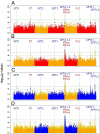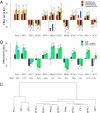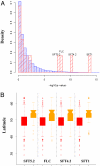Association mapping of local climate-sensitive quantitative trait loci in Arabidopsis thaliana
- PMID: 21078970
- PMCID: PMC3000268
- DOI: 10.1073/pnas.1007431107
Association mapping of local climate-sensitive quantitative trait loci in Arabidopsis thaliana
Abstract
Flowering time (FT) is the developmental transition coupling an internal genetic program with external local and seasonal climate cues. The genetic loci sensitive to predictable environmental signals underlie local adaptation. We dissected natural variation in FT across a new global diversity set of 473 unique accessions, with >12,000 plants across two seasonal plantings in each of two simulated local climates, Spain and Sweden. Genome-wide association mapping was carried out with 213,497 SNPs. A total of 12 FT candidate quantitative trait loci (QTL) were fine-mapped in two independent studies, including 4 located within ±10 kb of previously cloned FT alleles and 8 novel loci. All QTL show sensitivity to planting season and/or simulated location in a multi-QTL mixed model. Alleles at four QTL were significantly correlated with latitude of origin, implying past selection for faster flowering in southern locations. Finally, maximum seed yield was observed at an optimal FT unique to each season and location, with four FT QTL directly controlling yield. Our results suggest that these major, environmentally sensitive FT QTL play an important role in spatial and temporal adaptation.
Conflict of interest statement
The authors declare no conflict of interest.
Figures





References
-
- O'Neil P. Selection on flowering time: An adaptive fitness surface for nonexistent character combinations. Ecology. 1999;80:806–820.
-
- Michael TP, et al. Enhanced fitness conferred by naturally occurring variation in the circadian clock. Science. 2003;302:1049–1053. - PubMed
-
- Korves TM, et al. Fitness effects associated with the major flowering time gene FRIGIDA in Arabidopsis thaliana in the field. Am Nat. 2007;169:E141–E157. - PubMed
-
- Jung C, Müller AE. Flowering time control and applications in plant breeding. Trends Plant Sci. 2009;14:563–573. - PubMed
-
- Cockram J, et al. Control of flowering time in temperate cereals: Genes, domestication, and sustainable productivity. J Exp Bot. 2007;58:1231–1244. - PubMed
Publication types
MeSH terms
Grants and funding
LinkOut - more resources
Full Text Sources
Miscellaneous

